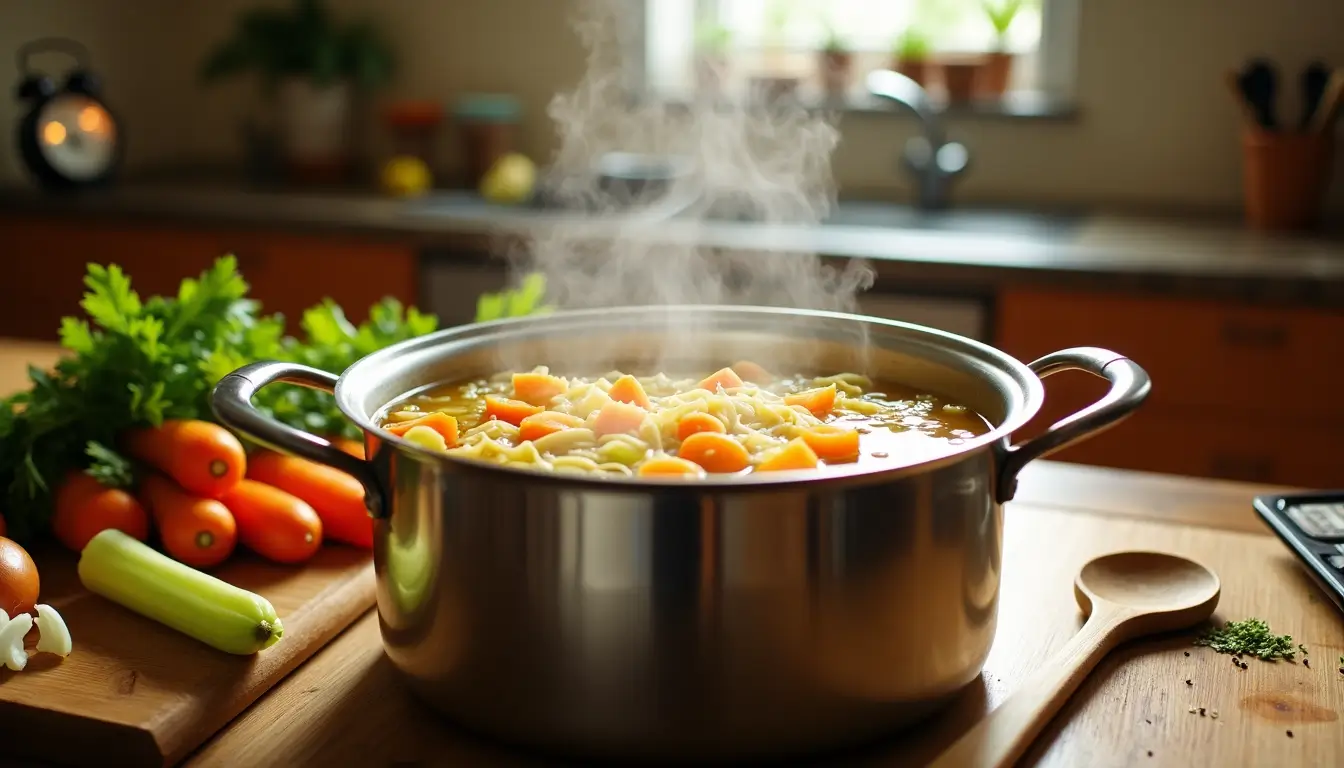A warm hug in a bowl – that’s exactly what the best chicken noodle soup recipe delivers to your family’s dinner table. If you’re wondering how to make chicken noodle soup that’s both delicious and comforting, look no further than this simple chicken soup recipe passed down through generations.
This classic comfort food takes just 40 minutes to prepare and serves 6 people, making it an ideal choice for family meals. Each serving of this easy chicken noodle soup contains 162 calories with 13g of protein, and the mix of carrots, celery, and onions makes it a nutritious and satisfying healthy soup.
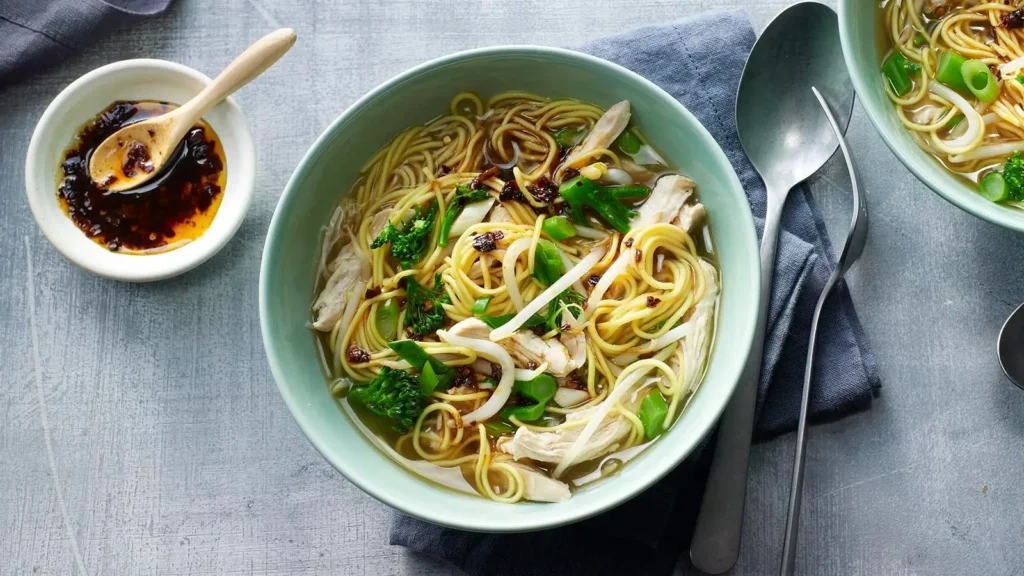
The perfect bowl needs more than just throwing ingredients together. This recipe works great with 8 cups of carefully prepared chicken broth, and you can even use rotisserie chicken as a time-saving option for a quick and easy chicken noodle soup with rotisserie chicken. Each ingredient plays a significant role in creating the final result, from the tender chicken to the flavorful egg noodles.
Our grandmother’s time-tested secrets blend perfectly with proven techniques that help you create the perfect homemade chicken noodle soup from scratch. Ready to become skilled at making this classic recipe? Let’s get cooking this hearty soup that’s perfect as a cold weather meal!
Table of Contents
Preparing Your Kitchen and Ingredients
The secret to a delicious homemade chicken noodle soup starts with the right tools and ingredients in your kitchen.
Essential Tools and Equipment
A heavy-bottomed Dutch oven is the life-blood of soup making and gives you superior heat retention with even cooking. On top of that, it helps to have an 8-quart stockpot that provides enough space to prepare your broth. An immersion blender is a great way to get the silkiest texture, and you can safely blend hot liquids right in the pot.
Your kitchen toolkit should include:
- Large wooden spoon to stir
- Ladle to measure stock
- Fine-mesh sieve to strain
- Sharp knife to prep vegetables
Ingredient Quality Checklist
The quality of your ingredients makes all the difference in your chicken noodle soup’s taste. Bone-in chicken pieces, such as chicken thighs, are the foundations of a rich, deep-flavored broth. Fresh herbs like parsley and thyme pack more punch than their dried counterparts. Don’t forget to add bay leaves for an extra layer of flavor.
Great soup starts with high-quality, unsalted stock or vegetable broth. Store-bought options work well, especially those with a darker color that indicates deeper flavor. Traditional egg noodles are the classic choice for homemade chicken noodle soup with egg noodles, but farfalle or elbow macaroni work just as well if you’re looking for noodle options.
Firm carrots, crisp celery, and fresh onions create the flavor base of your soup. A squeeze of fresh lemon juice brings balance and brightens up the finished dish. Don’t forget to season with salt and pepper to taste.
Building the Perfect Broth Base
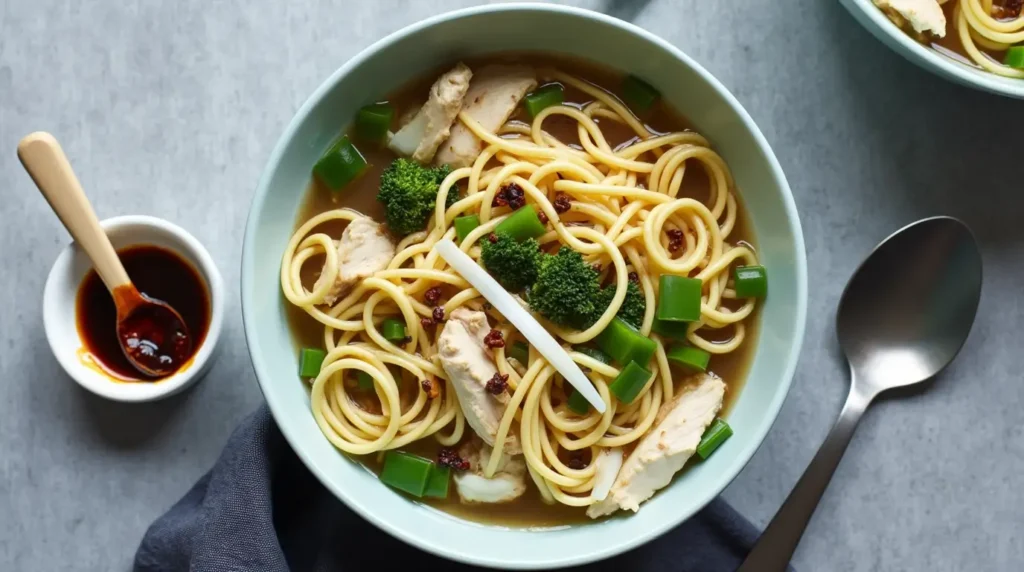
You need to become skilled at three techniques that lift a simple chicken soup recipe into a memorable dish.
Roasting Bones for Deeper Flavor
Roasting the bones reshapes the scene from an ordinary broth to something extraordinary. Raw chicken bones should go on a lined baking sheet to roast at 400°F for 20 minutes. The bones and pan juices will enrich the broth with deeper, more complex flavors when transferred to your stockpot, creating a homemade stock that’s far superior to store-bought options.
Vegetable Preparation Techniques
Proper vegetable preparation is the foundation of a flavorful broth. We cooked vegetables low and slow to sweeten rather than caramelize them. Your best results will come from:
- Start with unpeeled onions cut in half horizontally
- Add large carrots sliced into 3-inch pieces
- Include celery stalks cut similarly
- Incorporate whole garlic heads, halved through the cloves
Water-to-Ingredient Ratios
The water-to-ingredient ratio determines your broth’s intensity. A rich, flavorful base needs 16 cups (4 quarts) of filtered water for every 3-4 pounds of chicken bones. Adding 1 tablespoon of apple cider vinegar helps extract nutrients from the bones.
You’ll know the broth has reached perfect consistency when chicken bones break in half easily by hand. A gentle bubble should maintain during simmering – the surface breaks at irregular intervals to keep the broth clear instead of cloudy. The liquid level needs extra stock or water to stay consistent when it drops.
Mastering the Cooking Process
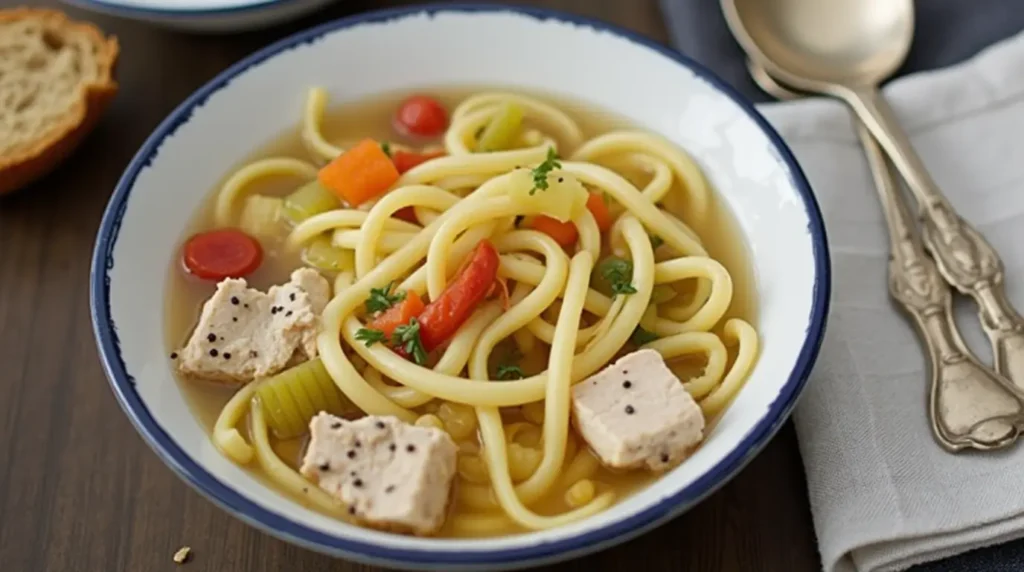
Temperature control is the life-blood of a perfect chicken noodle soup recipe.
Temperature Control Methods
The right temperature throughout the cooking process will give tender chicken and a clear, flavorful broth. We kept the stock temperature between 150°F and 160°F to get optimal results. Your temperature might vary slightly, but it should never go above 170°F.
To get the most tender chicken, cold-poach the meat before adding it to your soup. You need to bring the poaching liquid to 150°F and hold it there until the chicken’s thickest part reaches the same temperature. This method gives you perfectly cooked, juicy meat every time, whether you’re using chicken thighs or rotisserie chicken.
The surface should barely break with occasional bubbles as you add vegetables. This gentle approach keeps the broth from becoming cloudy. If you notice aggressive bubbling, reduce the heat right away.
To add egg noodles in the final stage:
- Bring the broth to a gentle boil
- Add noodles and cook for the package time minus 2 minutes
- Stir only once or twice during cooking
- Remove from heat while noodles are still slightly firm
Note that you should skim the surface during the first 30 minutes of cooking. You can get the clearest possible soup by refrigerating it until the fat sets on top, then remove this layer before reheating. The soup needs to reach 165°F for food safety, and stay at 135°F for serving.
For those looking to make homemade egg noodles, you can prepare them while the broth is simmering. This extra step can elevate your chicken noodle soup from scratch to a truly gourmet experience.
Storing and Reheating Your Soup
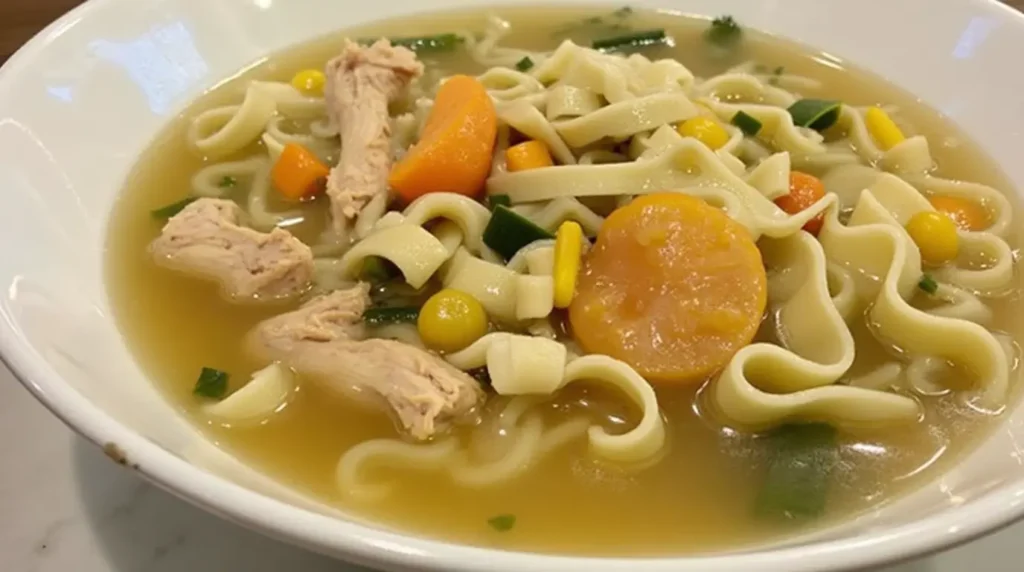
Your homemade chicken noodle soup will taste great and stay fresh for future meals with proper storage.
Freezing Tips
We cooled the soup to room temperature because hot soup in the refrigerator can lead to bacterial growth. The quickest way to cool it down is to split it into smaller portions. You can keep the cooled soup in airtight containers at 40°F or below in the refrigerator for up to 5 days. The soup stays good at 0°F or below in the freezer for up to 3 months.
Choose freezer-safe containers with extra space for expansion – they should only be three-quarters full. Label your containers with dates and contents to track them easily. These freezing instructions will help you enjoy your homemade soup even weeks after preparation.
Reheating Without Mushy Noodles
You can keep your egg noodles perfectly textured by storing them separately from the broth. Here’s how to reheat:
- Let the soup thaw overnight in the refrigerator
- Bring the broth to a gentle simmer on stovetop
- Drop in fresh noodles during final minutes
- Let them cook until they reach your preferred texture
The microwave works too – heat in 1-minute intervals and stir between each. Both methods need the soup to reach 165°F to be safe to eat.
Portion Control Guidelines
A half-cup of shredded chicken works well per person. Single-serving containers help avoid reheating the same batch multiple times. This makes your future meals convenient and preserves the soup’s quality.
Store these items separately to get the best results:
- Broth base in freezer-safe containers
- Cooked chicken in portion-sized bags
- Fresh noodles made just before serving
Your chicken noodle soup will taste as good as a restaurant’s, even after freezing. The soup stays delicious for up to six months in the freezer when stored correctly. These make-ahead instructions allow you to enjoy this comforting soup anytime, with minimal effort.
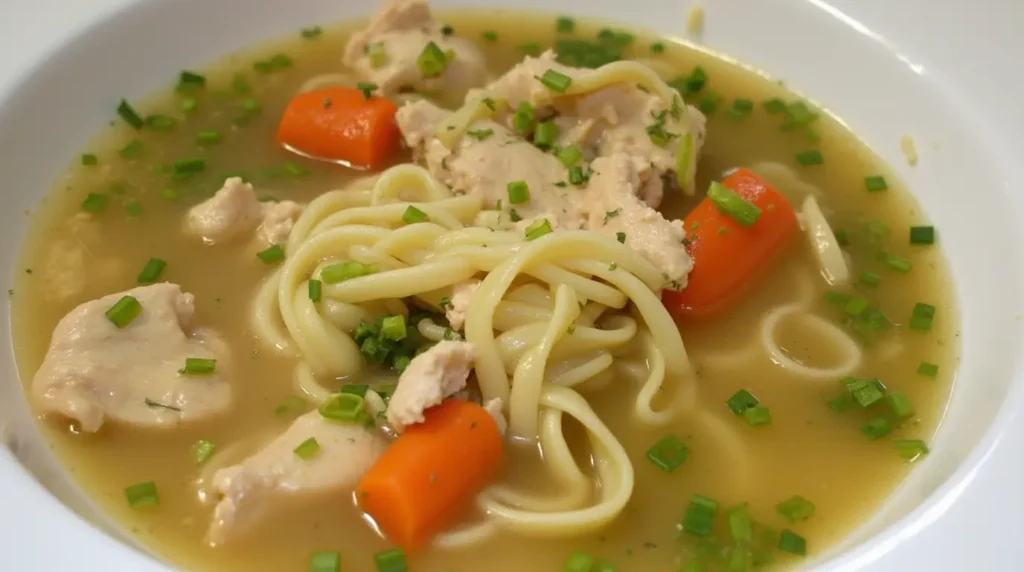
Conclusion
Perfect chicken noodle soup demands careful attention and time-tested techniques handed down through generations. Quality ingredients make all the difference, and you need the right temperature control to build a rich, flavorful broth base.
The right storage approach keeps your homemade soup fresh and tasty. You can preserve the noodles’ perfect texture and chicken’s tenderness by storing components separately and following temperature guidelines. On top of that, it helps to portion your soup smartly for quick, comforting meals whenever you need them.
This treasured recipe brings warmth and nourishment to your family’s table, exactly as our grandmother intended. The classic soup delivers both flavor and comfort when you’re fighting a cold or need warming up on a chilly evening. You’ll find more heartwarming recipes and nutritious meals at our “recipesnutritious.com” – where family traditions meet modern cooking techniques.
The perfect chicken noodle soup means more than following a recipe – it’s about sharing love through food, one steaming bowl at a time. Whether you’re making a simple chicken soup recipe or experimenting with flavor variations and seasoning tips, this versatile dish is sure to become a family favorite.
FAQs
Q1. What’s the key to making a flavorful chicken noodle soup? The key to a flavorful chicken noodle soup is building a rich broth base. This can be achieved by roasting chicken bones before adding them to the pot, using high-quality ingredients, and maintaining a proper water-to-ingredient ratio. Simmering vegetables low and slow also helps to develop deeper flavors. Adding herbs like parsley, thyme, and bay leaves can enhance the taste profile.
Q2. How can I prevent my noodles from becoming mushy in chicken soup? To prevent mushy noodles, cook them separately and add them to individual servings just before eating. When storing the soup, keep the noodles separate from the broth. If cooking noodles directly in the soup, add them during the final minutes of cooking and remove the pot from heat while they’re still slightly firm. This works well for both store-bought and homemade egg noodles.
Q3. What’s the best way to store homemade chicken noodle soup? For best results, cool the soup to room temperature before storing. Refrigerate in airtight containers at 40°F or below for up to 5 days, or freeze at 0°F or below for up to 3 months. Store broth, cooked chicken, and noodles separately to maintain quality and texture. Follow proper freezing instructions for long-term storage.
Q4. How do I reheat chicken noodle soup without overcooking the ingredients? To reheat without overcooking, thaw frozen soup in the refrigerator overnight. Then, gently simmer the broth on the stovetop and add fresh noodles during the final minutes of heating. Alternatively, use a microwave, heating in 1-minute intervals and stirring between each. Ensure the soup reaches 165°F for food safety. These make-ahead instructions help maintain the soup’s quality.
Q5. What vegetables work best in chicken noodle soup? Classic vegetables for chicken noodle soup include carrots, celery, and onions. These aromatics form the flavor base of the soup. For best results, use firm carrots, crisp celery, and fresh onions. Cut them into large pieces for simmering in the broth, and consider adding garlic for extra flavor. You can also experiment with other vegetables to create your own flavor variations of this hearty soup.

